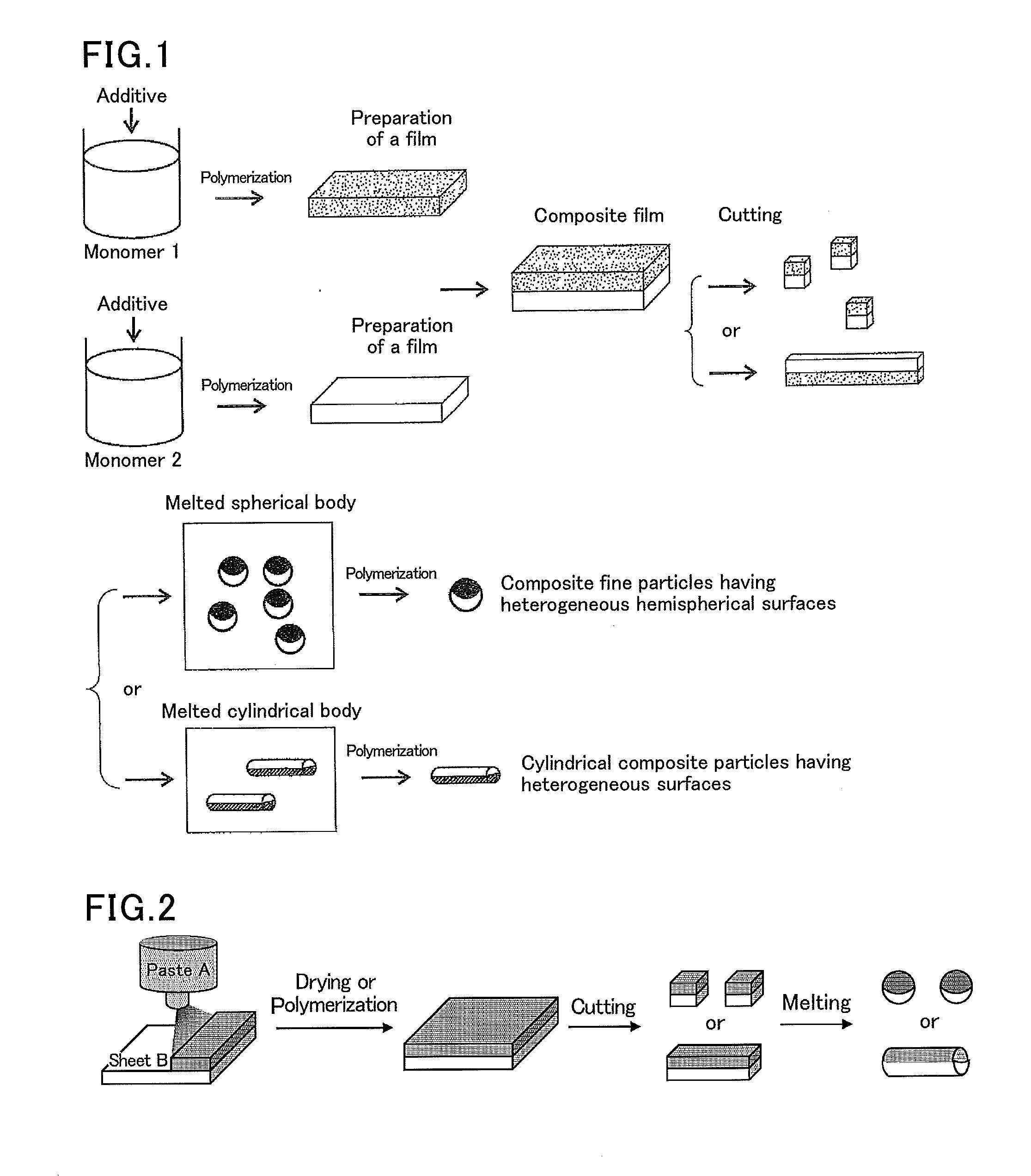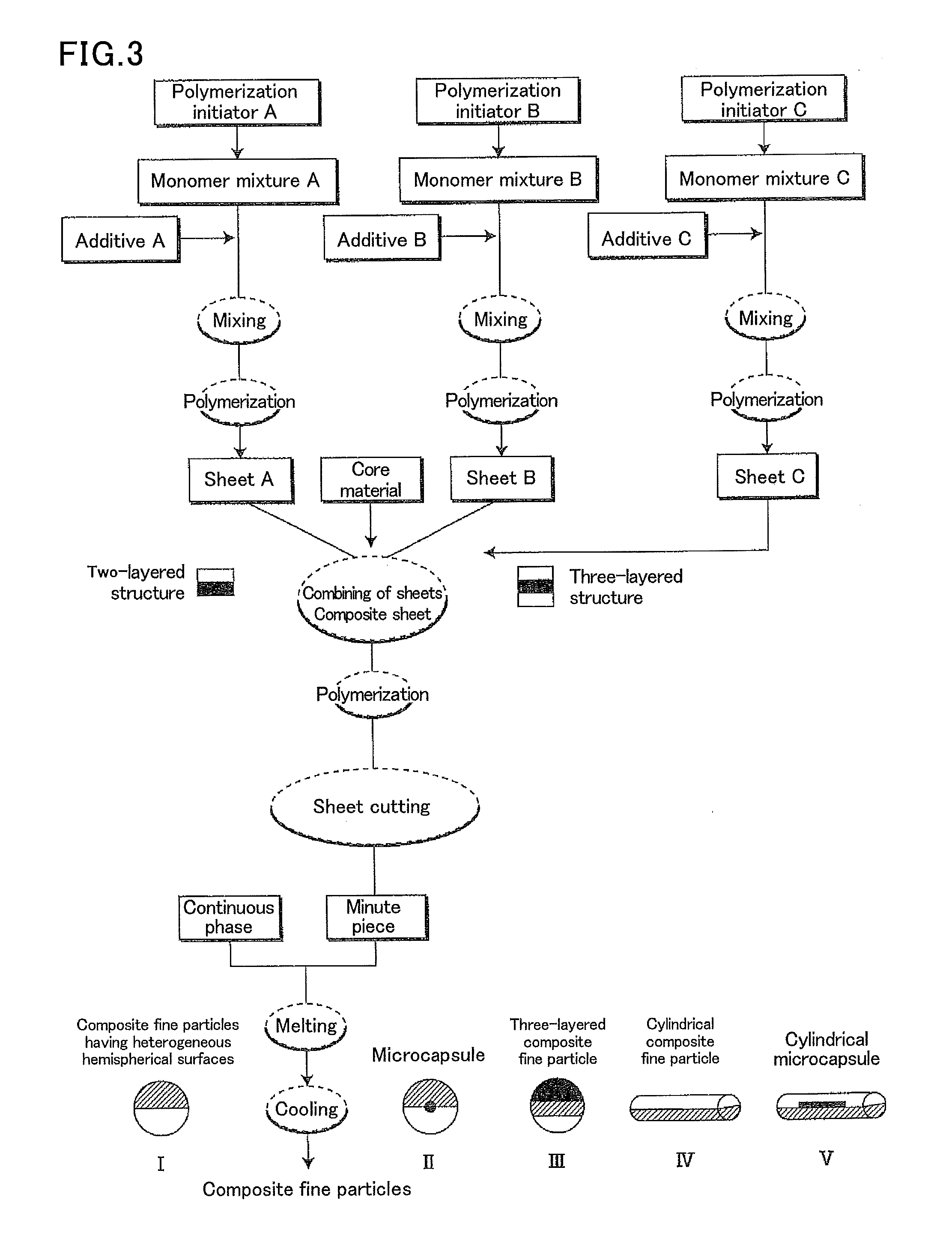Method for producing fine particles
a technology of fine particles and particle size distribution, which is applied in the field of producing fine particles, can solve the problems of increasing environmental load, complex process, and difficulty in producing fine particles with a uniform particle size distribution, and achieves the effect of low environmental load and high productivity
- Summary
- Abstract
- Description
- Claims
- Application Information
AI Technical Summary
Benefits of technology
Problems solved by technology
Method used
Image
Examples
example 1
[0079]A mixed solution of 2.5 g of polymethyl methacrylate, 2.5 g of polyisobutyl methacrylate, 5 g of MEK (methyl ethyl ketone), 5 g of butanol and 0.01 g of Neogen R (sodium dodecylbenzenesulfonate) used as a surface active agent was poured into a Petri dish and formed into a sheet by the cast method, thereby obtaining a sheet with a thickness of 50 μm.
[0080]Subsequently, the sheet was cut by using an excimer laser-type precise cutting machine (light source: ArF laser, wavelength: 193 nm) along lengthwise and widthwise directions orthogonally into a cut width of 50 μm (into a 50 μm square), and thus, minute pieces in a square pole shape with a size of 50 μm square were obtained.
[0081]The obtained minute pieces were introduced into a continuous phase at 80° C. to be melted into a spherical shape. Here, the used continuous phase was 0.5 g of polyvinyl alcohol and 2.5 g of tricalcium phosphate dissolved in 100 g of ethylene glycol. The obtained particles had an average particle size ...
example 2
[0084][Production of Black-White Fine Particles]
[0085]Composite fine particles were produced in accordance with the flowchart of FIG. 2 by using 5 g of a mixture of styrene and ethyl hexyl acrylate as monomer mixtures A and B, 0.5 g of AIBN (azobisisobutyronitrile) as polymerization initiators A and B, 0.6 g of a titanium dioxide (TiO2) powder of a white pigment as an additive A, 0.5 g of a magnetite (Fe3O4) powder of a black pigment as an additive B, 10 g of MEK as a solvent to be added to each of the monomer mixtures A and B, and 0.05 g of Span 80 (sorbitan monooleate) as a surface active agent to be added to each of the monomer mixtures A and B.
[0086]The polymerization initiator A, the additive A and the surface active agent were added to and mixed with the monomer mixture A, and preliminary bulk polymerization was performed for a prescribed period of time. Thereafter, the resulting mixed monomer was poured into a Petri dish and formed into a film by the cast method, and the prel...
example 3
[0090]A sheet A was prepared in the same manner as in Example 2 except that a mixed monomer was spin coated on glass and then preliminarily polymerized. The obtained sheet A had a thickness of 0.10 μm. A mixed monomer of the monomer mixture B similar to that obtained in Example 2 was spin coated on the sheet A, and thermal polymerization was performed for 10 minutes, thereby obtaining a composite sheet with a thickness of 0.19 μm.
[0091]This composite film was cut by using an excimer laser-type precise cutting machine along lengthwise and widthwise directions orthogonally into a cut width of 0.15 μm (into a 0.15 μm square), and thus, minute pieces in a square pole shape with a size of 0.15 μm square were obtained. The obtained minute pieces were introduced into a continuous phase at 80° C. to be melted into a spherical shape. Here, the used continuous phase was 0.5 g of polyvinyl alcohol and 2.5 g of tricalcium phosphate dissolved in 100 g of ethylene glycol.
[0092]Thereafter, the pol...
PUM
| Property | Measurement | Unit |
|---|---|---|
| width | aaaaa | aaaaa |
| thickness | aaaaa | aaaaa |
| thickness | aaaaa | aaaaa |
Abstract
Description
Claims
Application Information
 Login to View More
Login to View More - R&D
- Intellectual Property
- Life Sciences
- Materials
- Tech Scout
- Unparalleled Data Quality
- Higher Quality Content
- 60% Fewer Hallucinations
Browse by: Latest US Patents, China's latest patents, Technical Efficacy Thesaurus, Application Domain, Technology Topic, Popular Technical Reports.
© 2025 PatSnap. All rights reserved.Legal|Privacy policy|Modern Slavery Act Transparency Statement|Sitemap|About US| Contact US: help@patsnap.com



